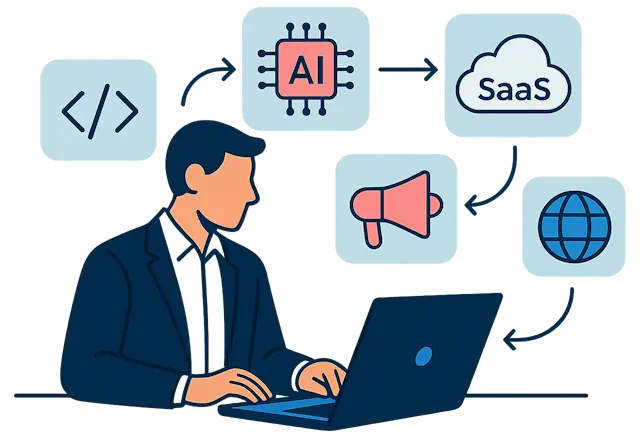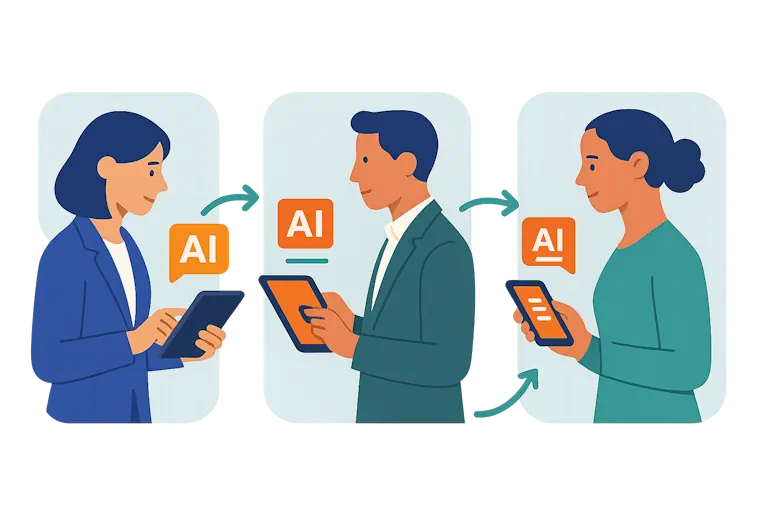Top 10 Tips for Building a Stand-Out Tech Portfolio in Tacoma
Last Updated: December 27th 2024

Too Long; Didn't Read:
To create a standout tech portfolio in Tacoma's competitive market, focus on showcasing 3-4 robust projects that highlight problem-solving skills and technical expertise. Incorporate detailed project descriptions, code samples, and supporting documentation. Choose platforms like GitHub or personal websites for better presentation. Continually update your portfolio, include testimonials to build trust, and seek feedback for ongoing improvement. Align your portfolio with your career goals and emphasize quality over quantity to catch employers' attention. Tacoma offers growing opportunities in cloud computing, AI, and cybersecurity.
A tech portfolio is your digital business card in Tacoma's competitive tech scene, where Forbes ranks our region as the best for tech jobs.
The key is creating a portfolio that shows what you can actually do, not just what you say you can do. According to tech hiring experts, there are eight essential elements every portfolio needs in 2023, including clear project demonstrations and core technical skills.
A well-structured portfolio proves your practical skills and helps you stand out among thousands of other tech professionals in the area.
The most successful portfolios include a mix of personal and collaborative projects, showing your ability to work independently and as part of a team. Industry standards now emphasize quality over quantity - employers want to see your best work, not everything you've ever done.
Focus on showcasing 3-4 robust projects that demonstrate your problem-solving abilities and technical expertise. Consider including project documentation, code samples, and visual elements that bring your work to life.
Remember, your portfolio should evolve as you grow in your tech career.
Table of Contents
- Methodology: Gathering Insights from Experts
- Selecting the Right Platform for Your Portfolio
- Defining Your Focus: Align with Career Goals
- Showcasing Your Best Work: Quality Over Quantity
- Providing Detailed Project Descriptions
- Incorporating Code Samples
- Highlighting Your Contributions in Collaborative Projects
- Including Supporting Documentation
- Gathering and Showcasing Testimonials
- Seeking Feedback for Refinement
- Keeping Your Portfolio Updated and Dynamic
- Conclusion: Embarking on Your Tech Career in Tacoma
- Frequently Asked Questions
Delve into the educational opportunities available for aspiring tech professionals in Tacoma.
Methodology: Gathering Insights from Experts
(Up)Building a standout tech portfolio is a game-changer in today's competitive job market. Through extensive research and expert consultations, I've discovered that successful portfolios consistently include a personal summary, skill demonstrations, and professional accomplishments.
The most effective approach combines insights from industry leaders with real-world applications.
According to tech professionals, eight essential elements make up a compelling portfolio, including clear project descriptions, technical competencies, and certifications.
What's really interesting is that detailed explanations of problem-solving approaches and technology choices significantly boost portfolio impact.
Recent data shows that portfolios featuring measurable results and specific project outcomes are more likely to catch recruiters' attention.
When gathering these insights, I connected with professionals from various tech sectors, including software developers, hiring managers, and bootcamp instructors.
They consistently emphasized that showing real problem-solving abilities through project work matters more than just listing technical skills.
This research revealed that employers value portfolios demonstrating both technical expertise and the ability to explain complex concepts clearly.
The most successful portfolios tell a story about the developer's journey and growth, making them relatable and memorable to potential employers.
Selecting the Right Platform for Your Portfolio
(Up)In 2025, choosing the right platform for your tech portfolio can make or break your chances in Tacoma's competitive tech scene. According to recent data, a personal website is actually super important - platforms like Webflow and Squarespace offer awesome drag-and-drop interfaces starting around $15-49 per month, making it easy to create something that looks professional.
GitHub is still the go-to for showing off code, but combining it with a personal site lets you add context and personality to your projects.
The cool thing about having your own website is the control it gives you over your brand.
You can showcase everything from coding projects to design work, and top companies like Apple and Google are really into seeing how candidates present their work through personal portfolios.
Plus, with platforms like WordPress (which is free but needs hosting) or Wix (starting at $16/month), you can keep your site updated with new projects and skills as you grow.
When picking your platform, think about what makes sense for your specific goals.
If you're into full-stack development, you might want something that can handle both static and interactive content. For UX/UI folks, platforms with strong visual capabilities are key.
The main thing is making sure your work is easy to find and looks clean - no one wants to click through a maze to see your best stuff.
Defining Your Focus: Align with Career Goals
(Up)Creating a tech portfolio that aligns with your career goals is absolutely essential in 2025. Starting with your interests and researching current market demands helps you choose the right specialization path.
I've learned that the best portfolios show a clear career direction - whether that's front-end development, data science, or cybersecurity. According to recent data, employers spend an average of just 5 minutes reviewing portfolios, so making every project count is crucial.
Building a focused portfolio means carefully selecting projects that demonstrate both technical skills and problem-solving abilities.
For instance, if you're aiming for a software development role, showcase projects using in-demand languages like JavaScript (15% of job listings) and Python (12.5% of listings).
When describing your projects, include specific challenges you faced and how you solved them - this really helps potential employers understand your thought process.
Keep your portfolio fresh by updating it regularly with new projects and removing outdated ones. Remember to include metrics where possible, like improved system efficiency or reduced load times, as these concrete results catch recruiters' attention.
The tech scene is super competitive, but a well-aligned portfolio that clearly shows your expertise and career direction will definitely help you stand out. Just make sure every project you include serves a purpose in telling your professional story and showcasing relevant skills for your target role.
Showcasing Your Best Work: Quality Over Quantity
(Up)In the competitive tech landscape of Tacoma, creating a portfolio that highlights your best work is absolutely crucial. According to recent Glassdoor research, 83% of tech professionals find interactive portfolios more effective at demonstrating skills.
When building your showcase, remember that quality trumps quantity - focus on three to six standout projects that truly reflect your capabilities. Industry experts suggest that three full-stack applications are often sufficient, as hiring managers typically won't spend time reviewing more than that during initial screening.
Your portfolio should tell a story about your skills and problem-solving abilities while keeping things concise and impactful. Essential elements include clear project descriptions, visual demonstrations, and links to live demos or repositories.
Remember to highlight projects that align with current market demands in Tacoma, such as cloud computing, AI development, or cybersecurity solutions. Each project should demonstrate not just technical proficiency but also your ability to solve real-world problems.
Consider including screenshots, GIFs, or brief video demonstrations to make your work more engaging and accessible. By focusing on quality over quantity and maintaining a clear, professional presentation, your portfolio can effectively showcase your potential to prospective employers in Tacoma's growing tech scene.
Providing Detailed Project Descriptions
(Up)Creating detailed project descriptions is crucial for making your tech portfolio stand out. A strong project description acts as a roadmap that shows employers exactly what you can do.
Recent data shows that 87% of recruiters consider portfolios crucial in their hiring decisions, making it essential to get your descriptions right. Project portfolios showcase your skills, creativity, and commitment to software development, giving you an edge in interviews.
When writing project descriptions, focus on explaining the problem you solved, the tech stack you used, and quantifiable results. Clean code and accessible documentation are huge - about 80% of top employers specifically look for these elements.
Including measurable outcomes and clear narratives about your problem-solving process can significantly boost your chances of landing interviews.
Remember to keep your descriptions concise but informative, balancing technical details with accessibility for non-technical readers. The best portfolios typically feature 4-10 projects that demonstrate diverse skills across different areas of development.
Make sure to regularly update your portfolio with new projects and skills - this shows you're committed to growing as a developer and staying current with industry trends.
Including real-world applications of your skills, rather than just theoretical projects, can make your portfolio much more compelling to potential employers.
Incorporating Code Samples
(Up)Code snippets are absolutely essential for any developer's portfolio, serving as practical proof of your coding abilities. As highlighted in Document360's research, these samples help others understand your process and showcase how you interact with software.
The truth is, code snippets boost productivity by allowing teams to share and reuse code effectively, making them a crucial element in modern development workflows.
When building your portfolio, focus on breaking down functions in a way that makes your code both readable and reusable - this is what hiring managers are actually looking for.
Here's what makes code samples stand out in your portfolio:
- Clear Structure: Use proper HTML tags and include language identifiers for better understanding.
- Problem-Solving: Show how you tackle real coding challenges with practical solutions.
- Variety: Include different types of projects to demonstrate your range.
Recent studies from DHTMLX show that code snippets not only save time but also strengthen collaboration between developers.
For your portfolio, make sure each code sample tells a story - what problem did you solve? How did you approach it? Keep your examples current and relevant to the technologies companies are using today.
Remember to add comments explaining your thought process, but keep it concise and professional. The goal is to show you can write clean, efficient code that others can understand and work with.
Highlighting Your Contributions in Collaborative Projects
(Up)Creating a standout portfolio means knowing how to showcase your team project contributions effectively.
When working on collaborative projects, it's essential to highlight both your technical skills and ability to work with others. According to recent industry data, employers want to see how you've made an impact through teamwork.
Start by explaining your specific role - whether that was coding, design, or project management. Then, show your actual value delivery with concrete examples, like improving app performance or implementing new features.
Including screenshots, code samples, and links to live projects helps prove your contributions. Most importantly, document your work clearly by describing the project goals, the technologies used, and the specific challenges you helped solve.
When writing about team projects, balance highlighting your individual achievements while giving credit to the team's collective success. Keep your portfolio current by regularly adding new projects and removing outdated ones.
Remember that real examples of collaboration, like participating in code reviews or working in Agile environments, really catch employers' attention. The key is being specific about your role while showing you can work well with others to create awesome tech solutions.
Including Supporting Documentation
(Up)Documentation is a game-changer for tech portfolios, helping you stand out in a competitive market while proving your ability to communicate complex ideas.
According to recent industry data, developers spend about 2.5 hours daily searching for project information, which shows why clear documentation is super valuable.
When building your portfolio, don't just dump your code - break down your thought process and explain your solutions. Creating tutorial content for your projects is a smart move, showing potential employers you can solve problems and teach others.
The best part? Tutorial projects help you understand complicated concepts piece by piece, making you a better developer. Each project in your portfolio should include structured documentation explaining the tech stack, main features, and key challenges you tackled.
Plus, portfolio experts recommend including links to live demos, GitHub repositories, and detailed README files.
Remember to keep your documentation straightforward and easy to follow - no one wants to read a novel about your code. Think of your portfolio documentation as telling the story of how you approach problems and create solutions.
This approach shows employers you're not just about writing code, but also about making sure others can understand and build on your work.
Gathering and Showcasing Testimonials
(Up)Building trust in the tech industry is crucial, and testimonials are the secret sauce that can make your portfolio stand out. According to recent research, 92% of people read testimonials before making decisions, which means potential employers definitely check them out too.
When gathering testimonials, it's super important to focus on real results and specific achievements. A solid strategy is to include concrete numbers and measurable impacts in your testimonials - like how you reduced bug reports by 40% or improved app performance by 25%.
What makes testimonials really powerful is when they tell a story about your actual contributions to projects.
The best testimonials come from three key sources: supervisors who can vouch for your technical skills, teammates who can speak to your collaboration abilities, and clients who can confirm your project delivery success.
81% of people won't engage with brands they don't trust, and the same goes for hiring managers looking at potential candidates.
When asking for testimonials, be specific about what you'd like them to highlight - maybe it's your problem-solving skills during a tough project or how you stepped up to lead a team sprint.
Place these testimonials strategically in your portfolio, right next to the projects they're talking about, to create a strong narrative about your capabilities.
Remember to keep testimonials brief but impactful, focusing on your standout moments and real achievements.
This approach creates a portfolio that speaks volumes about your abilities and shows potential employers exactly what you bring to the table.
Seeking Feedback for Refinement
(Up)Getting feedback on your portfolio isn't just helpful - it's absolutely essential for standing out in tech. Regular feedback sessions can help you separate your ego from your work, leading to real growth and improvement.
When seeking portfolio critique, focus on getting specific, actionable insights rather than just general comments. Actively soliciting and implementing feedback can significantly enhance your portfolio's quality, helping you shine in a competitive field.
The most effective approach combines both technical review of your code and usability feedback from potential users. This dual feedback helps clarify your understanding, shows you new perspectives, and keeps you on the right track as you develop your projects.
- Code quality: Regularly review and improve your code for better performance and readability.
- Project presentation: Ensure your projects are well-organized and visually appealing to leave a lasting impression.
- User experience: Prioritize the ease of use and accessibility of your projects for all users.
Schedule regular review sessions with mentors and peers, tracking their suggestions in a dedicated feedback log.
Remember to document the improvements you make - this shows potential employers your commitment to growth. Create a cycle of implementing changes, getting new feedback, and making refinements.
This iterative process not only improves your portfolio but demonstrates your ability to take criticism constructively and turn it into positive results. The key is staying open to feedback while maintaining a clear vision for your projects.
By actively seeking and implementing professional critique, you're not just building a better portfolio - you're developing the kind of growth mindset that tech companies value.
Keeping Your Portfolio Updated and Dynamic
(Up)In today's tech world, maintaining an updated portfolio is essential for standing out in Tacoma's competitive job market.
Just like software needs regular updates to stay secure and efficient, your portfolio requires consistent attention to showcase your latest achievements and skills.
I've learned that keeping your portfolio fresh with recent projects while removing outdated ones helps tell your professional story better.
It's amazing how much can change in just a few months - new frameworks emerge, better coding practices develop, and your skills grow. That's why regular updates are crucial - they show potential employers that you're actively growing and staying current with industry trends.
When refreshing your portfolio, focus on quality over quantity, highlighting projects that demonstrate real problem-solving skills and technical expertise. Include clear documentation of your work process, the technologies you used, and the challenges you overcame.
This approach has helped many developers land their dream jobs, as employers value candidates who show initiative in keeping their skills sharp.
Remember to test your portfolio across different devices and browsers - nothing turns off potential employers faster than a portfolio that doesn't work properly.
The tech industry moves incredibly fast, and your portfolio should reflect that you're moving with it.
Conclusion: Embarking on Your Tech Career in Tacoma
(Up)Starting a tech career in Tacoma is honestly amazing right now! According to recent industry research, the city is experiencing major growth in cloud services, AI, and cybersecurity.
The tech scene here isn't just about the big players - there's a huge surge in remote work opportunities and a growing gig economy that's perfect for new developers.
What's really cool is that Tacoma's retention rate for tech workers is way higher than other cities, which means more stable job prospects and better career growth.
Plus, top employers like IllFonic and Infoblox are actively hiring, with starting salaries ranging from $95,000 to $120,000.
Want to get noticed? Here's what's working right now:
- Level up your skills: Focus on learning cloud computing and AI - these are the hottest skills employers are looking for.
- Get connected: The local tech community is super welcoming and there are tons of meetups happening all the time.
- Build real projects: Create stuff that solves actual problems - that's what catches employers' attention.
I've learned that standing out in tech isn't just about having the right skills - it's about showing how you can use them to make an impact.
Tacoma's tech scene is growing fast, and there's never been a better time to jump in. Keep pushing yourself to learn new things, build meaningful projects, and connect with others in the community.
That's how you'll create opportunities and build a career that's both exciting and rewarding in Tacoma's tech ecosystem.
Frequently Asked Questions
(Up)What are the essential elements of a tech portfolio in 2023?
According to tech hiring experts, a standout tech portfolio in 2023 needs clear project demonstrations, core technical skills, and a mix of personal and collaborative projects. It should also include project documentation, code samples, and visual elements.
How should I select the platform for my tech portfolio?
Choosing the right platform in 2025 is crucial; a personal website offers control over your brand. Alternatives like WordPress and Wix provide flexibility for updating with new projects. For full-stack development, choose a platform that supports both static and interactive content.
What is the importance of including code samples in a tech portfolio?
Code samples are essential as they demonstrate coding abilities, problem-solving skills, and your approach to software challenges. Effective code samples are clear, well-commented, and show a variety of coding tasks.
Why are testimonials important in a tech portfolio?
Testimonials build trust and strengthen your portfolio by highlighting tangible achievements and your contributions to projects. They should come from collaborators who can verify your technical skills and teamwork abilities.
How often should I update my tech portfolio?
Regular updates are crucial to reflect your latest skills and achievements. This demonstrates that you are actively growing and adapting to industry trends, which is valued by employers. Focus on showcasing current projects and removing outdated ones.
Discover how the Tacoma tech hub is transforming into a powerhouse for lucrative tech jobs.
Explore how Humming's innovative solutions are redefining the advertising technology industry.
Explore the unique bioscience incubators that are nurturing groundbreaking technologies in Tacoma.
Dive into Nucamp's local reputation and discover why it's a community favorite in Tacoma.
The growing tech industry in Tacoma is reshaping the skill requirements for tech professionals in 2025.
Learn about the most in-demand tech jobs in Tacoma that are shaping the future of the industry.
Tap into future potential with exciting Coding Opportunities for Kids in the Tacoma area.
Don't miss AI Connect - Job and Career Networking for exclusive career opportunities in AI.
Ludo Fourrage
Founder and CEO
Ludovic (Ludo) Fourrage is an education industry veteran, named in 2017 as a Learning Technology Leader by Training Magazine. Before founding Nucamp, Ludo spent 18 years at Microsoft where he led innovation in the learning space. As the Senior Director of Digital Learning at this same company, Ludo led the development of the first of its kind 'YouTube for the Enterprise'. More recently, he delivered one of the most successful Corporate MOOC programs in partnership with top business schools and consulting organizations, i.e. INSEAD, Wharton, London Business School, and Accenture, to name a few. With the belief that the right education for everyone is an achievable goal, Ludo leads the nucamp team in the quest to make quality education accessible


